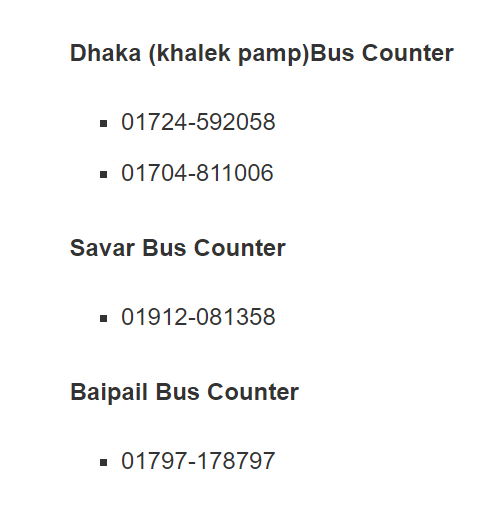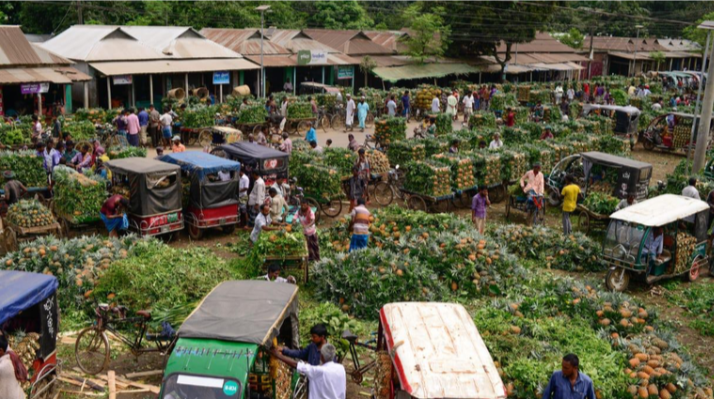Dhaka to Madhupur Garh & Bus schdule and Pineapple market
Madhupur (Bengali: মধুপুর) is a town of Madhupur Upazila, Tangail, Bangladesh. The town is 51 km northeast of Tangail city, 47 km southwest of Mymensingh, and 137 km northwest of Dhaka, the capital.
Madhupur National Park covers an area of 8,436 ha (20,850 acres). The Forest was established as a national park by the Bangladesh government in 1962 but, was officially declared as a National park in 1982 under the Bangladesh Wildlife (Preservation) Amendment Act of 1947. The park is located at Madhupur Upazila, Tangail District in the North region of the country. It is about 125 kilometers (78 mi) away from Dhaka. The local topography mainly consists of flat-topped ridges (Chalas) intersected by numerous depressions (Baids). [2] The park is easily accessible by road throughout the year. The park is a famous tourist spot due to its natural and scenic beauty.
Introduction to Madhupur Garh
The general walk in the forest is easy due to the flat terrain. About 40% of the forest area is covered with Sal (Shorea robusta) trees. Madhupur forests are considered one of the best sal forests in entire Bangladesh. The sal trees grow in association with Dillenia pentagonal, Lagerstroemia parviflora, Adina cordifolia, Miliusa velutina, Lannea Grandis, Albizia spp., Bauhinia variegata, Spondias Mangifera, Butea frondosa, and Barringtonia acutangula. The undergrowth is shrubby, which includes Eupatorium odoratum, Pennisetum setosum, Asparagus racemosus, and Rauvolfia serpentine. Plantations of Teak Tectona grandis, Cassia siamea, Morus spp., Terminalia arjuna, and Syzygium cumini were made in the parking area.[2] 176 plant species were identified in the park, which include 73 tree species, 22 shrub species, 27 climbers, 45 medicinal plants, 8 grasses and 1 palm species.[1]
Fauna
Since long back, Madhupur forest was rich in wildlife and was famous for tigers.[2] The fauna consists of 190 species which include 21 mammals, 140 birds, and 29 snakes.[1]
Human settlement
There is large human habitation inside and along the National park area. Some 4500 Garo tribals were allowed for the settlement inside the park in 1968.in 1989 the human population was about 14,000. Mainly paddy is cultivated in plains and pineapple and cassava is cultivated as a commercial crop on higher lands.
Madhupur is a large upland area in the central part of Bangladesh. The southern part of this tract is known in Bangla as Bhawal Garh and the northern part as Madhupur Garh.
Dhaka to Madhupur Bus Schdule

AC Binimoy Bus Opening Hours
Monday: 6:30 AM – 11:00 PM
Tuesday: 6:30 AM – 11:00 PM
Wednesday: 6:30 AM – 11:00 PM
Thursday: 6:30 AM – 11:00 PM
Friday: 6:30 AM – 11:00 PM
Saturday: 6:30 AM – 11:00 PM
Sunday: 6:30 AM – 11:00 PM
AC Binimoy Bus Ticket Counter Number
Dhanbari: 01713-579227
Madhupur: 01708-969556
Ghatail: 01708-969557
Baipail: 01797-178797,
Savar, Dhaka: 01912-081358
Dhaka: 01724592058, 01704811006

Pineapple farmers in Madhupur upazila
Pineapple farmers in Madhupur upazila of Tangail district have seen a bumper production of the fruit — around 209,512 tons — this season. According to the Department of Agriculture Extension (DAE), around 28,000 acres of land in the upazila was used for pineapple production. The Giant Q variety was largely grown and the Honey Queen variety was produced in about 500 acres of land.
Farmers said it costs Tk10-12 to produce a pineapple. The big pineapple is being sold at TK25 each, medium ones TK15, and the small ones at Tk5.
Madhupur tourist place
- Madhupur Rubber Garden Office
- Forest Office, Modhupur National Park
- Pirgasa Rubber Bagan
- Palbari Mosque
- Municipal Park
- Dhanbari Nawab Shahi Jame Mosque
- Madhupur Forest National Park
- Nourish Horticulture
- Bangabandhu Udyan
- National forest Ghatail, Bangladesh
- Botanical Garden
- Madhupur Garh



